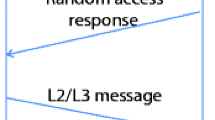Abstract
The adaptive packet aggregation algorithm (AAM) has been shown to have a superior performance over the first-in first-out (FIFO) algorithm in terms of the throughput and delay (Deng and Davis in International conference on wireless communications and signal processing 2013 (WCSP2013), Hangzhou, China, pp 449–504, 2013; 20th IEEE symposium on communications and vehicular technology in the Benelux 2013 (IEEE SCVT 2013), Namur, 2013). In this paper, we will show that when compared with the FIFO and smallest-size first-served algorithms, the AAM algorithm has the best performances in terms of the trade-off between the overhead saving and the average delay under mixed traffic loads in wireless LANs. The simulation results show that the AAM algorithm produces the largest average aggregate packet size.




Similar content being viewed by others
References
IEEE Standard 802.11n. (2009). Amendment 5: Enhancements for higher throughput.
Deng, J., & Davis, M. (2013). An adaptive packet aggregation algorithm for wireless networks. In International conference on wireless communications and signal processing 2013 (WCSP2013) (pp. 449–504), Hangzhou, China, October 24–26, 2013.
Deng, J., & Davis, M. (2013). The performance of the adaptive aggregation mechanism (AAM) in lossy wireless networks. In 20th IEEE symposium on communications and vehicular technology in the Benelux 2013 (IEEE SCVT 2013), Namur, November 21, 2013.
Selvam, T., & Srikanth, S. (2010). A frame aggregation scheduler for IEEE 802.11n. In National conference on communications 2010 (NCC’10) (pp. 1–5), Chennai, India, January 29–31, 2010.
Kuo, Y.-W. (2007). Throughput analysis for wireless LAN with frame aggregation under mixed traffic. In 2007 IEEE Region 10 conference (TENCON 2007) (pp. 1–4), Taipei, October 30–November 2, 2007.
Saif, A., Othman, M., Subramaniam, S., & Abdulhamid, N. (2010). Impact of aggregation headers on aggregating small MSDUs in 802.11n WLANs. In International conference on computer applications and industrial electronics 2010 (ICCAIE’10) (pp. 630–635), Kuala Lumpur, Malaysia, December 5–8, 2010.
Seyedzadegan, M., Othman, M., Ali, B. M., & Subramaniam, S. (2011). Wireless mesh networks: WMN overview, WMN architecture. In International conference on communication engineering and networks 2011 (Vol. 19, pp. 12–18), Hong Kong, China, November 25–27, 2011.
Author information
Authors and Affiliations
Corresponding author
Rights and permissions
About this article
Cite this article
Deng, J., Davis, M. The Performance of the Adaptive Aggregation Mechanism (AAM) Under Mixed Traffic Loads. Wireless Pers Commun 79, 1733–1739 (2014). https://doi.org/10.1007/s11277-014-1955-0
Published:
Issue Date:
DOI: https://doi.org/10.1007/s11277-014-1955-0




